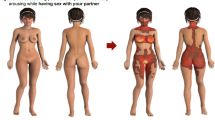Abstract
Tactile classical conditioning of an autonomic reflex (pupillary dilation and constriction) and a somatic response (eyeblinking) was attempted in two separate experiments with one-month-old infants. The tactile CS was effective for conditioning eyeblinking but was ineffective for elaborating conditional pupillary reflex dilation or constriction. These differences were related to the interaction between stimulus and response in infant conditioning and the source of nervous system innervation of the CR as it relates to conditionability.
Similar content being viewed by others
References
Abrahamson, D., Brackbill, Y., Carpenter, R., and Fitzgerald, H. E.: Interaction of stimulus and response in infant conditioning.Psychosom. Med.,32: 319–325, 1967.
Brackbill, Y., and Fitzgerald, H. E.: Development of the sensory analyzers during infancy.In Lipsitt, L. P. and Reese, H. W. (eds.):Advances in Child Development and Behavior Vol. 4. New York, Academic Press, 1969.
Brackbill, Y., Fitzgerald, H. E., and Lintz, L. M.: A developmental study of classical conditioning.Monographs of the Society for Research in Child Development,32: No. 8, 1967.
Brackbill, Y., and Koltsova, M. M.: Conditioning and learning. In Brackbill, Y. (ed.): Infancy and Early Childhood. New York, Free Press, 1967.
Brackbill, Y., Lintz, L. M., and Fitzgerald, H. E.: Differences in the autonomie and somatic conditioning of infants.Psychosom. Med.,30: 193–201, 1968.
Fitzgerald, H. E., and Brackbill, Y.: Interstimulus interval in classical pupillary conditioning.Psychol. Rep.,23: 369–370, 1968.
Fitzgerald, H. E., Lintz, L. M., Brackbill, Y., and Adams, G.: Time perception and conditioning an autonomic response in human infants.Percept. Motor Skills,24: 479–486, 1967.
Gantt, W. H.: Principles of nervous breakdown: schizokinesis and autokinesis,Ann. NY Acad. Sci.,56: 143–163, 1953.
Lintz, L. M., and Fitzgerald, H. E.: Apparatus for eyeblink conditioning in infants.J. Exp. Child Psychol,4: 276–279, 1966.
Lintz, L. M., Fitzgerald, H. E., and Brackbill, Y.: Conditioning the eyeblink response to sound in infants.Psychon. Sci.,7: 405–406, 1967.
Miller, S., and Konorski, J.: Sur une forme particuliére des reflexes conditionnels.Compte Rendu Hebdomadaire des Séances et Mémoires de la Société de Biologie,99: 1151–1157, 1928.
Mowrer, O. H.: On the dual nature of learning—a re-interpretation of “conditioning” and “problem-solving.”Harvard Educ. Rev.,17: 102–148, 1947.
Osgood, C. E.: Method and Theory in Experimental Psychology. Oxford University Press, 1953.
Patten, H. D.: The autonomic nervous system.In Ruch, T. C., Patton, H. D., Woodhury, J. W., and Towe, A. L. (eds.). Neurophysiology Ed. 2. Philadelphia, W. B. Saunders, 1965.
Schlosberg, H.: The relationship between success and the laws of conditioning.Psychol. Rev.,44: 379–394, 1937.
Skinner, B. F.: The Behavior of Organisms: An Experimental Analysis. New York, Appleton-Century-Crofts, 1938.
Turner, L. H., and Solomon, R. L.: Human traumatic avoidance learning: Theory and experiments on the operant-respondent distinction and failures to learn.Psychol. Monogr.,76: (Whole No. 559), 1962.
Author information
Authors and Affiliations
Additional information
This research was supported in its preliminary stages by USPHS Grant MH-14100 to Dr. Fitzgerald and throughout by NSF Research Grant GB 4784 and USPHS Research Career Grant MH 5925 to Dr. Brackbill. The authors would like to express their appreciation to Mr. Michael little for his invaluable assistance throughout the research project.
Rights and permissions
About this article
Cite this article
Fitzgerald, H.E., Brackbill, Y. Tactile conditioning of an autonomic and somatic response in young infants. Conditional Reflex 6, 41–51 (1971). https://doi.org/10.1007/BF03000266
Issue Date:
DOI: https://doi.org/10.1007/BF03000266




